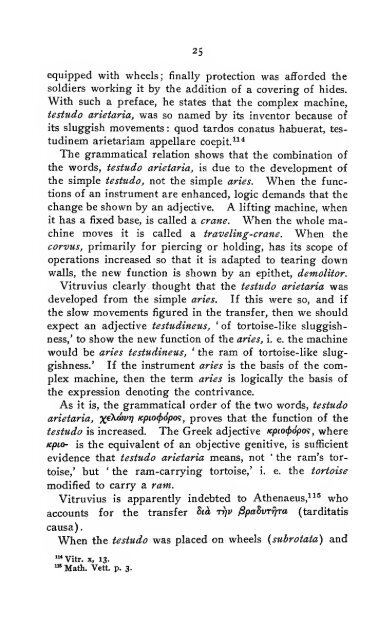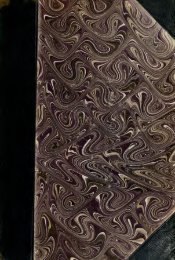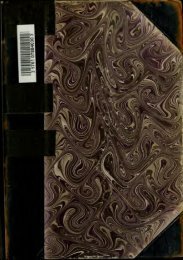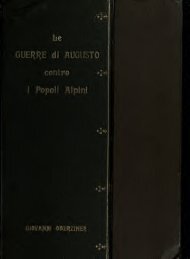Figurative uses of animal names in Latin and their ... - mura di tutti
Figurative uses of animal names in Latin and their ... - mura di tutti
Figurative uses of animal names in Latin and their ... - mura di tutti
Create successful ePaper yourself
Turn your PDF publications into a flip-book with our unique Google optimized e-Paper software.
25<br />
equipped with wheels; f<strong>in</strong>ally protection was afforded the<br />
sol<strong>di</strong>ers work<strong>in</strong>g it by the ad<strong>di</strong>tion <strong>of</strong> a cover<strong>in</strong>g <strong>of</strong> hides.<br />
With such a preface, he states that the complex mach<strong>in</strong>e,<br />
iestudo arieiaria, was so named by its <strong>in</strong>ventor because <strong>of</strong><br />
its sluggish movements : quod tardos conatus habuerat, testud<strong>in</strong>em<br />
arietariam appellare coepit."*<br />
The grammatical relation shows that the comb<strong>in</strong>ation <strong>of</strong><br />
the words, testudo arietaria, is due to the development <strong>of</strong><br />
the simple testudo, not the simple aries. When the func-<br />
tions <strong>of</strong> an <strong>in</strong>strument are enhanced, logic dem<strong>and</strong>s that the<br />
change be shown by an adjective. A lift<strong>in</strong>g mach<strong>in</strong>e, when<br />
it has a fixed base, is called a crane. When the whole ma-<br />
ch<strong>in</strong>e moves it is called a travel<strong>in</strong>g-crane. When the<br />
corvus, primarily for pierc<strong>in</strong>g or hold<strong>in</strong>g, has its scope <strong>of</strong><br />
operations <strong>in</strong>creased so that it is adapted to tear<strong>in</strong>g down<br />
walls, the new function is shown by an epithet, demolitor.<br />
Vitruvius clearly , thought that the testudo arietaria was<br />
developed from the simple aries. If this were so, <strong>and</strong> if<br />
the slow movements figured <strong>in</strong> the transfer, then we should<br />
expect an adjective testud<strong>in</strong>eus, ' <strong>of</strong> tortoise-like sluggishness,'<br />
to show the new function <strong>of</strong> the aries, i. e. the mach<strong>in</strong>e<br />
would be aries testud<strong>in</strong>eus, ' the ram <strong>of</strong> tortoise-like sluggishness.'<br />
If the <strong>in</strong>strument aries is the basis <strong>of</strong> the com-<br />
plex mach<strong>in</strong>e, then the term aries is logically the basis <strong>of</strong><br />
the expression denot<strong>in</strong>g the contrivance.<br />
As it is, the grammatical order <strong>of</strong> the two words, testudo<br />
arietaria, xeXeoi/T; Kpio^opm, proves that the function <strong>of</strong> the<br />
testudo is <strong>in</strong>creased. The Greek adjective icpio^opm, where<br />
Kpio- is the equivalent <strong>of</strong> an objective genitive, is sufficient<br />
evidence that testudo arietaria means, not ' the ram's tor-<br />
toise,' but ' the ram-carry<strong>in</strong>g tortoise,' i. e. the tortoise<br />
mo<strong>di</strong>fied to carry a ram.<br />
Vitruvius is apparently <strong>in</strong>debted to Athenaeus,^^^ who<br />
accounts for the transfer Sta t^k ^paSvrrjra (tar<strong>di</strong>tatis<br />
causa).<br />
When the testudo was placed on wheels (subrotata) <strong>and</strong><br />
"* Vitr. X, 13.<br />
"» Math. Vett. p. 3.



![Das Kriegswesen der Alten [microform] - mura di tutti](https://img.yumpu.com/21606999/1/167x260/das-kriegswesen-der-alten-microform-mura-di-tutti.jpg?quality=85)








